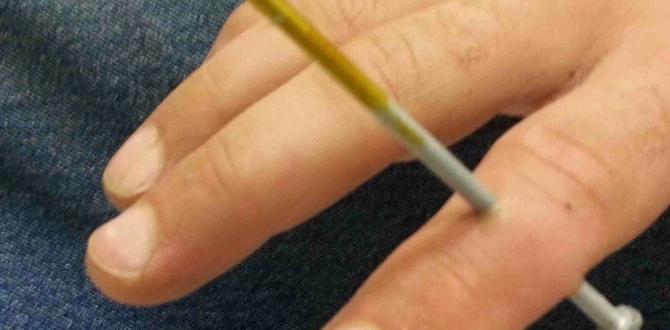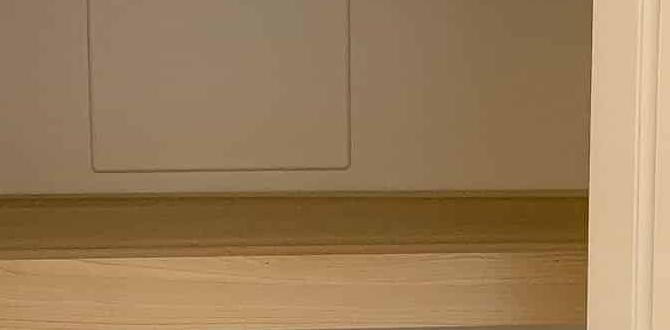Have you ever tried to cut with a bandsaw and faced problems? Maybe the blade wobbled or didn’t cut straight. One big reason could be blade tension. Learning how to set bandsaw blade tension can change everything.
Imagine you are working on a special project. You want your cuts to be perfect, but something feels off. That’s when understanding blade tension comes in. Did you know that too much or too little tension can ruin your work?
Setting the right tension on your bandsaw blade isn’t just a simple task. It can make your cutting experience smooth and easy. With the right adjustments, you can turn your bandsaw into a trusty tool that helps you create amazing things.
Ready to dive in? Let’s explore how to set bandsaw blade tension. You’ll soon see how small changes can lead to big results!
Table of Contents
How To Set Bandsaw Blade Tension For Optimal Performance
Setting the right tension on your bandsaw blade is crucial for smooth cuts and safety. Too loose, and the blade can wander; too tight, and it may break. Start by checking the manufacturer’s guidelines for tension settings. Use a tension gauge if you have one for accuracy. Did you know that proper tension can extend the life of your blade? Regularly adjust it based on the type of wood and the thickness you’re cutting. Safe and precise cuts await!
Understanding Bandsaw Blade Tension
Importance of proper blade tension. Effects of incorrect tension on cutting performance.
Getting the bandsaw blade tension just right is like finding the perfect fit for your favorite shoes. Too tight? You’ll be hopping around like a kangaroo. Too loose? It’s like trying to cut butter with a dull knife! Proper tension is vital for smooth cuts. If it’s off, your blade may wander, making your wood look like a roller coaster instead of a straight track.
| Blade Tension | Impact |
|---|---|
| Correct | Straight cuts and smooth performance. |
| Too Tight | Increased wear and possible blade breakage. |
| Too Loose | Uneven cuts and blade drifting. |
So, pay attention to your bandsaw blade tension—it can make the difference between a master craftsman and a lumberjack in training!
Tools Required for Setting Blade Tension
List of essential tools (tension gauge, tools for adjustment). Safety equipment needed during the process.
Getting ready to set your bandsaw blade tension? You’ll need a few handy tools! First up, a tension gauge helps you check how tight the blade is. You’ll also need some adjustment tools, like a wrench or screwdriver, to make those changes easily. Safety should always come first, so don’t forget your goggles and gloves. They’re like your superhero gear when working with power tools! Here’s a quick look:
| Tools | Purpose |
|---|---|
| Tension Gauge | Checks blade tightness |
| Wrench/Screwdriver | Adjusts tension |
| Goggles | Protects your eyes |
| Gloves | Keeps your hands safe |
Identifying the Right Tension for Your Blade
Factors influencing blade tension (blade type, material thickness). Manufacturer guidelines for different bandsaw blades.
Finding the right tension for your bandsaw blade is important. Think about the blade type and the thickness of the material you’re cutting. A thicker material needs more tension, like a tightrope walker needing to balance properly! Each bandsaw blade comes with manufacturer guidelines, so be sure to check those. Below is a handy table to help you understand the recommended tension:
| Blade Type | Material Thickness | Recommended Tension |
|---|---|---|
| Wood | Up to 1 inch | Low |
| Wood | 1-2 inches | Medium |
| Metal | Up to 1 inch | High |
| Metal | Over 1 inch | Very High |
Following the right tension will help you cut smoothly without any hiccups. Remember, a well-tensioned blade is a happy blade!
Step-by-Step Guide to Setting Blade Tension
Preparing the bandsaw for adjustments. Detailed steps to increase or decrease tension.
Before you start adjusting the blade tension, make sure your bandsaw is clean and unplugged—safety first! Now, loosen the tension wheel. If you hear any creaks, it’s probably your bandsaw complaining about being too tight! To adjust, simply turn the tension wheel clockwise to increase tension or counterclockwise to decrease it. Keep an eye on the gauge. You want that sweet spot where the blade feels snug, but not like it’s auditioning for a circus act!
| Adjustment | Action |
|---|---|
| Increase Tension | Turn the wheel clockwise |
| Decrease Tension | Turn the wheel counterclockwise |
Remember, the proper tension helps your blade last longer and keeps your cuts straight. Like a well-strung guitar, a properly tensioned blade plays beautifully!
Common Tensioning Mistakes to Avoid
Overtensioning vs. undertensioning effects. Misunderstanding blade compatibility with tension settings.
Tensioning your bandsaw blade is key, but many make silly mistakes. Overtensioning can lead to blade breakage, making your saw behave like it’s auditioning for a horror movie. On the flip side, undertensioning can cause your cuts to be as crooked as a toddler’s drawing. Each blade is different and has a preferred tension setting. Misunderstanding these needs can make you look like a confused puppy. Remember, right tension equals happy cuts!
| Error Type | Outcome |
|---|---|
| Overtensioning | Blade breakage |
| Undertensioning | Uneven cuts |
| Mismatched blade tension | Poor performance |
Testing Blade Tension after Adjustment
Methods for testing tension (using a tension gauge). Visual and performance checks postadjustment.
After adjusting the bandsaw blade tension, checking it is a must! Using a tension gauge is like sending your blade to the gym to see if it’s pumped enough. A little twist and turn can reveal if the tension is just right or needs more effort. You should also do some visual and performance checks. Look for any signs of wobbling or odd sounds. If it sounds like a cat in a blender, it’s time for adjustments! Here’s a quick comparison table for your reference:
| Method | Description |
|---|---|
| Tension Gauge | Measures the exact tension, ensuring it’s appropriate for cutting. |
| Visual Check | Look for blade alignment and any unusual bending. |
| Performance Check | Listen for strange noises and monitor the cut quality. |
Test early and often to keep your blade strong and sharp!
Maintenance Tips for Bandsaw Blades
Regular tension checks and adjustments. Keeping blades clean and wellmaintained.
To keep bandsaw blades in top shape, check their tension regularly. Proper tension prevents blade slipping and ensures smooth cuts. Adjust the tension as needed. Also, clean blades often to remove sawdust and debris. Dirty blades can cause poor performance. Regular maintenance will extend blade life and improve accuracy.
How often should I check my bandsaw blade tension?
It’s best to check the tension each time you use the bandsaw or after significant cuts.
Quick Tips for Maintenance:
- Check tension before each use.
- Keep blades clean with a brush.
- Store blades properly when not in use.
Conclusion
In conclusion, setting bandsaw blade tension is crucial for safe and accurate cutting. You should aim for the right tension to prevent blade issues. Check your bandsaw’s manual for specific guidelines. Practice adjusting the tension each time you use the saw. By doing this, you’ll improve your skills and ensure better results. For more tips, consider reading further guides on bandsaw maintenance!
FAQs
What Are The Signs That Indicate A Bandsaw Blade Needs Proper Tensioning?
You can tell a bandsaw blade needs more tension if it makes weird noises while cutting. If the blade wobbles or moves around, that’s another sign. You might also see the blade bending or twisting. Finally, if your cuts aren’t straight, it’s time to check the tension! Make sure the blade is tight for better cutting.
How Do You Determine The Correct Tension For Different Types Of Bandsaw Blades?
To determine the right tension for bandsaw blades, you first check the type of blade you have. Each kind needs a different tightness. You can look at the blade’s instructions for guidance. Next, you can press on the blade gently. If it bends too much, it’s too loose; if it doesn’t bend at all, it’s too tight. Adjust until it feels just right!
What Tools Or Equipment Are Necessary For Measuring Bandsaw Blade Tension Accurately?
To measure the tension of a bandsaw blade accurately, you need a blade tension gauge. This tool shows if the blade is tight enough. You might also use a ruler to check the blade’s length. Finally, a wrench can help you adjust the blade if it’s too loose or too tight.
How Does Improper Blade Tension Affect The Performance And Longevity Of A Bandsaw Blade?
Improper blade tension can cause problems for your bandsaw blade. If the blade is too loose, it can wobble and cut unevenly. If it’s too tight, it can break faster. This means you won’t be able to use it for a long time. Taking care of the tension helps the blade work better and last longer.
Are There Any Specific Techniques Or Tips For Maintaining Consistent Blade Tension During Use?
To keep your blade tension steady while using it, check the tension regularly. You can do this by testing it with your hand. If it feels loose, tighten it a bit. It helps to use a ruler to measure tension if possible. Also, make sure your tools are clean and in good shape, as this can help everything work better.







